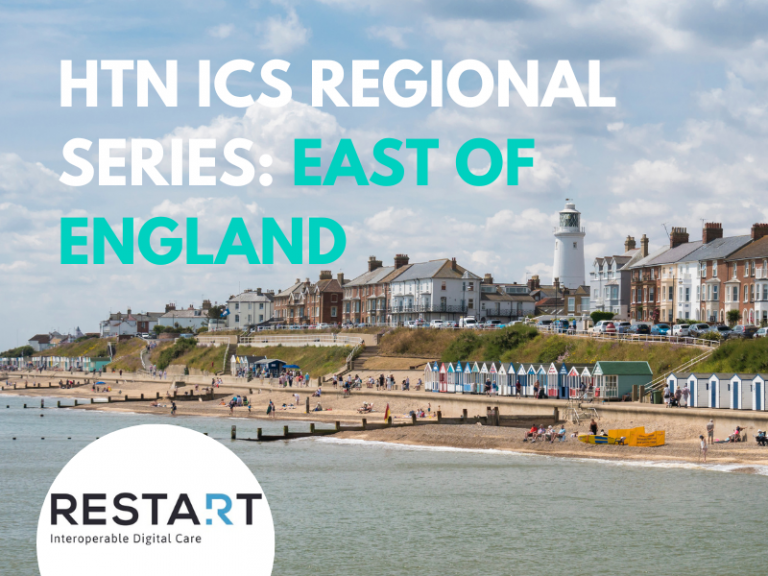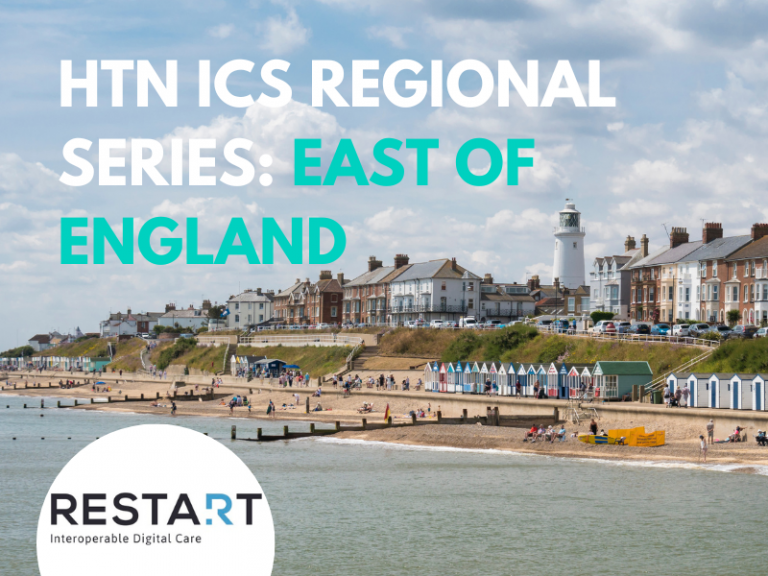
Adam Lavington, director of digital transformation at Hertfordshire and West Essex ICB, told us that the main digital priorities at present for his ICB are around investing in “proven technology” in areas including supporting care in the community, offering more same day care, and reducing pressures on A&E. Examples include increased information sharing and falls prevention/detection technology in care homes, and digital telephony in primary care and virtual wards. The ICB is also prioritising elective recovery and reducing waiting times, “investing in technology that improves and shows patient flow in our hospitals”; and focusing on empowering patients with patient portals “enabling patients to be informed, make choices, and take ownership of their own care.”
When it comes to digital projects, Adam shared that he is particularly proud of the ICS’s work on developing a “very mature” shared care record, “with all providers connected and sharing data including providers in Cambridge, Essex and London to name a few”, and with the record “passing one million views in the last few weeks”. Adam said that this is “transforming care and triaging patients to the right care setting, saving time by reducing unnecessary tests, and keeping patients informed much faster than was previously possible; not to mention saving lives.” Adam also highlighted progress around digital social care records, with over 80 percent of the ICS’s social care providers now using a digital care record, which he credits with “improving care, increasing recording of incidents, reducing paper, and improving data collection compliance.”
Over the next 12 months, Adam told us that whilst progress and priorities are dependent on funding, aims include “new replacement patient records in two acute hospitals, pushing more uptake and usage of the NHS app capabilities, and implementing advanced care plans for a yet-to-be-agreed cohort, subject to funding approval”. He added that the ICB also intends to “deploy acoustic monitoring devices to care homes and have a new data platform enabling us to use data to commission services and manage population health.”
From Mid and South Essex ICS, main digital priorities as featured in the ICSs digital strategy are around “digitise, connect, and transform”. A representative from the ICS told us: “At its core, the strategy emphasises collaboration across all parts of our health and social care system, including acute community, mental health, primary care, and the VCSE sectors.”
The ICS is prioritising digital initiatives which make a difference to the collective health and care provision across Mid and South Essex and its borders; improving “the commonality of solutions and their ability to communicate with each other, thereby better catering to the needs of the workforce and population”; and “driving up digital maturity in line with the ‘What Good Looks Like’ framework”.
To achieve “such fundamental transformation”, the ICS “must prepare for the future and ensure our digital foundations are robust. This involves modernising software and operating systems, reducing the number of systems in use, resolving networking challenges, improving WiFi coverage, and introducing modern telephone systems. Additionally, enhancing our cybersecurity at both organisational and system levels is critical. These enhancements will help us meet our future goals and deliver better care for our residents.”
What digital progress so far inspires particular pride in Mid and South Essex? A key component of the ICS’s digital strategy is the upcoming launch of the region’s shared care record, which “will bring together key information from various health and social care records into a structured and easy-to-read format”, and provide professionals with a holistic view of a person’s clinical and care history, “facilitating better connected care and safer treatment”. The ICS also highlighted implementing a unified EPR as “one of the most significant clinical transformation programmes across Mid and South Essex NHS Foundation Trust and Essex Partnership University NHS Foundation Trust”, with “significant progress” being made in setting up the EPR programme for success, and “the intention of going live with our new EPR in 2026/27”.
Plans for the future include reducing the number of duplicate systems and paper-based processes, standardising and automating processes, making progress on a new patient portal, and introducing Athena, described as “an ICS-wide strategic data and analytics platform” which “uses cloud-based technologies to integrate separate data sources into one system, creating a single source of truth” and supporting population health management, decision-making and care delivery.
Bedfordshire, Luton and Milton Keynes (BLMK) ICS shared priorities around their data strategy, which will see “healthcare staff across primary care, hospitals, community and mental health services have an improved level of health data available to them”, through rolling out the region’s shared health and care record and making improvements “to the way we analyse and report data”. According to the ICS, the data strategy “will help to identify those people with greater health and social care needs” as well as supporting self-care and making care “more tailored to the individual”.
BLMK added that work around digital “is also about supporting our teams to do their jobs, making the best use of our resources, and making it easier for services and care providers to work together”, with websites and apps supporting patient access and software and tools providing staff with more time to focus on care.
Sharing some of the digital projects from the past year that the region is particularly proud of, the ICS highlighted the Share For Care project”to enable health and social care professionals across Bedfordshire, Luton and Milton Keynes to share a single digital health and care record about each person they care for”. The ICS is also planning to share patient information, where relevant, with health and care providers outside Bedfordshire, Luton and Milton Keynes, with Milton Keynes University NHS Trust already sharing data with providers who are part of the London Care Record, including providers in Hertfordshire and West Essex.
Digitising social care has also been a focus in the past year, with focus on to “reducing the chances of residents developing serious health issues that require a hospital stay” through “remote monitoring, increased use of digital records and falls prevention”. Through case studies, videos, newsletters and an annual conference, “local care providers have engaged with the programme and implemented a number of tools and systems – benefiting staff and residents alike”.
On the future of digital health in the region over the next 12 months, the ICS shares that its Enhanced Wellbeing Through Digital programme “will offer technology to support adults to live independently, reduce avoidable hospital admissions/re-admissions, and improve care quality and safety”. This will include the use of PainChek, an electronic device designed to help identify and manage pain for those who are unable to communicate it verbally by measuring small changes in facial expressions and voice to quantify a pain score. Additionally, “around 1,300 care home residents will be provided with a robotic companion to provide comfort and decrease loneliness” with the Robopets innovation providing “a calming influence”, and giving people “greater independence and confidence”, as well as hopefully improving mental health and wellbeing.
In a statement from Mark Stanton, chief information officer at East and North Hertfordshire NHS Trust, the trust’s use of the Alertive app is highlighted as a significant development in the use of digital technology, offering “a new way for clinicians to receive emergency messages through a mobile phone application”.
Mark said: “Using Alertive, users will be able to send urgent notifications to their colleagues when they need support, enabling them to instantly provide more information about a patient’s condition than is currently possible through a bleep. We expect Alertive to improve communication between staff by providing a clearer and more concise messaging service for teams and departments across the Trust, supporting more collaborative and aligned patient care.”
Cambridge University Hospitals NHS Foundation Trust shared details of two major projects from the last year, including a collaboration between GigXR, Cambridge University Hospitals and the University of Cambridge Faculty of Education on “medical training using mixed reality technology”. This is designed to help healthcare professionals looking to enhance their clinical skills to “use holographic patients to practice high-level, real-time decision making and treatment choice”. Training modules include emergency scenarios and deteriorating chronic conditions that lead to hospitalisation, focusing on “the responses and human factors needed to provide accurate care”.
The second project highlighted by the trust is the use of AI in tackling waiting times for cancer patients, with the OSAIRIS solution enabling specialists to “plan for radiotherapy treatments approximately two and a half times faster than if they were working alone, ensuring more patients can get treatment sooner and improving the likelihood of cure”. By outlining the organs in a process known as “segmentation” which usually takes doctors “between 20 minutes and three hours” per patient, the solution saves clinician time.



